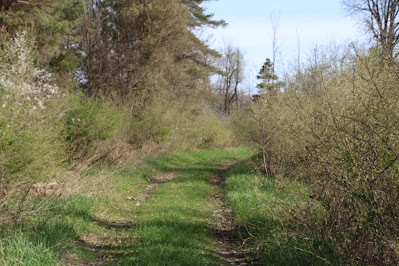It’s mostly sunny with temperatures in the upper 40’s as I make my way through the three-acre Riverbank Preserve and pause to observe water of the south branch of the Pine River flow gently past me. This watercourse begins its journey at the Blanchard Millpond, about two miles to the northwest. From where I stand, it continues southeast about two miles before spilling into the main branch of the Pine River (stock photo). Nearby, I spot a Black Willow tree displaying its female flowers. These trees are dioecious, with female flowers on one tree and male flowers on others. Male flowers are yellowish in color (stock photo). Near the ground, blanketing a decaying log is a patch of Baby Tooth Moss, displaying needle-like sporophyte stalks topped with tiny capsules, filled with spores. Next, I stoop down to notice a single fertile shoot of Common Horsetail emerging from the green grass. Later on a vegetative shoot will emerge with bright green conifer-like foliage growing around the stems (stock photo). The name “horsetail” arose because this vegetative stage resembles a horse's tail. Up ahead, I pause to hear the familiar sound of a male Song Sparrow. Like many other songbirds, this bird uses its song to attract mates as well as defend its territory. Laboratory studies have shown that the female Song Sparrow is attracted not just to the song itself, but to how well it reflects the ability of the male to learn. Males that used more learned components in their songs were preferred. High in a tall tree, I hear the territorial call of a male Redwing Blackbird. Looking more closely, I see its spreading tail feathers, another behavior for defending its nesting area in the cattails below. Male blackbirds are polygynous. Each male holds a territory for a harem of five to 15 females. The advantage of such an arrangement is that the male can defend this territory, and the females find safety within the group. Glancing up, I spot the drooping female flowers from a Box Elder tree. This species is also dioecious with male and female flowers on separate trees. Male flowers (stock photo) hang in clusters on the outer buds of branches and later turn brown before withering away. Each female flower is replaced by a pair of samaras (winged seeds) that often hang on through the winter (stock photo). Just off the trail, I see a May Apple plant that has was zapped by a hard freeze, unlike a healthy one (stock photo). On the way back to the car, I first hear a couple of noisy Canada geese fly overhead and then pause to admire blossoms on a Pin Cherry tree.
End of April
Into the wild
Life and death
Are reconciled
Flesh and bone
Creature gives
Food to survive
Predator lives
Down the path
Barren field
Carcass aside
Sprouts revealed
D. DeGraaf



